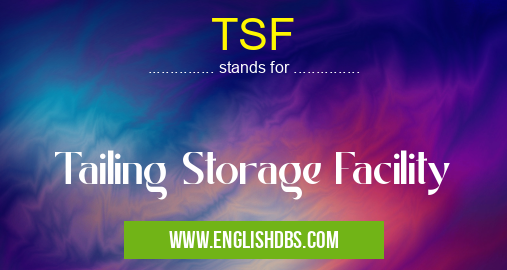What does TSF mean in UNCLASSIFIED
TSF (Tailing Storage Facility) is an engineered structure designed to store and manage tailings, a waste product generated from mining operations. Tailings are typically composed of finely ground rock, minerals, and other materials that are separated from the valuable ore during mineral processing. TSFs play a crucial role in ensuring the safe and environmentally sound disposal of tailings, minimizing their impact on the surrounding environment.

TSF meaning in Unclassified in Miscellaneous
TSF mostly used in an acronym Unclassified in Category Miscellaneous that means Tailing Storage Facility
Shorthand: TSF,
Full Form: Tailing Storage Facility
For more information of "Tailing Storage Facility", see the section below.
Types of TSFs
There are various types of TSFs, each with its own design and operational characteristics:
- Embankment Dams: Constructed using earth, rock, or a combination of both, these TSFs create a physical barrier to contain tailings.
- Tailings Dams: Similar to embankment dams, but with an engineered core made of impermeable materials to enhance stability and prevent seepage.
- Tailings Impoundments: Depressions or natural basins that are excavated to store tailings without the construction of physical structures.
- Dry Stacking: A method where tailings are deposited in a dry, stackable form, eliminating the need for water storage.
Design and Construction
The design and construction of TSFs involve meticulous planning and engineering considerations to ensure structural integrity and environmental protection. Factors such as tailings characteristics, topography, water management, and seismic risks are carefully assessed to determine the appropriate TSF type and design.
Operational Management
TSFs require continuous operational management to maintain their stability and minimize environmental risks. This includes:
- Tailings Management: Controlling the flow, deposition, and consolidation of tailings within the facility.
- Water Management: Managing water inflows, seepage, and evaporation to maintain the desired water level and prevent contamination.
- Monitoring and Inspection: Regular monitoring of TSF performance, including structural stability, water quality, and vegetation health.
Environmental Considerations
TSFs are designed and operated to minimize their environmental impact. Key considerations include:
- Seepage Control: Preventing the uncontrolled release of contaminated water into surrounding ecosystems.
- Tailings Stability: Ensuring the long-term stability of tailings to prevent catastrophic failures.
- Dust Control: Minimizing the generation and dispersion of dust from dry tailings.
Essential Questions and Answers on Tailing Storage Facility in "MISCELLANEOUS»UNFILED"
What is a Tailing Storage Facility (TSF)?
A TSF is a designated area for storing and managing the solid waste or byproducts generated from mining operations. These facilities are designed to safely contain and prevent the release of tailings, which can be harmful to the environment and human health.
Why are TSFs necessary?
TSFs are essential for storing and managing the large volumes of tailings produced by mining operations. Tailings, consisting of finely ground rock and minerals, must be securely contained to prevent environmental contamination and protect water sources.
How are TSFs constructed?
TSFs typically involve the construction of embankments, often made of earth or rock, to create a containment structure. The design and construction of TSFs adhere to strict engineering and environmental standards to ensure their stability and safety.
What are the environmental concerns associated with TSFs?
Improperly managed TSFs can pose environmental risks, including:
- Leakage or seepage of contaminants into groundwater and surface water
- Dust generation and air pollution
- Potential for dam failure and catastrophic releases
How are TSFs monitored and regulated?
TSFs are subject to stringent monitoring and regulation by government agencies to ensure their safety and environmental compliance. Monitoring typically includes regular inspections, water quality monitoring, and geotechnical assessments.
What happens to tailings stored in TSFs?
Tailings can be stored in TSFs indefinitely or until they are processed or reclaimed for other uses. Some tailings may be suitable for use in construction materials or other industrial applications.
What measures are taken to minimize risks associated with TSFs?
To mitigate risks, TSFs incorporate various safety measures, such as:
- Dam safety inspections and maintenance
- Seepage and groundwater monitoring systems
- Emergency response plans
- Regular monitoring and auditing
Final Words: Tailing Storage Facilities play a vital role in the safe and responsible management of tailings from mining operations. Through careful design, construction, and operational management, TSFs effectively contain tailings and minimize their environmental impact. Continuous monitoring, maintenance, and regulatory oversight are essential to ensure the long-term safety and sustainability of these facilities.
TSF also stands for: |
|
| All stands for TSF |
